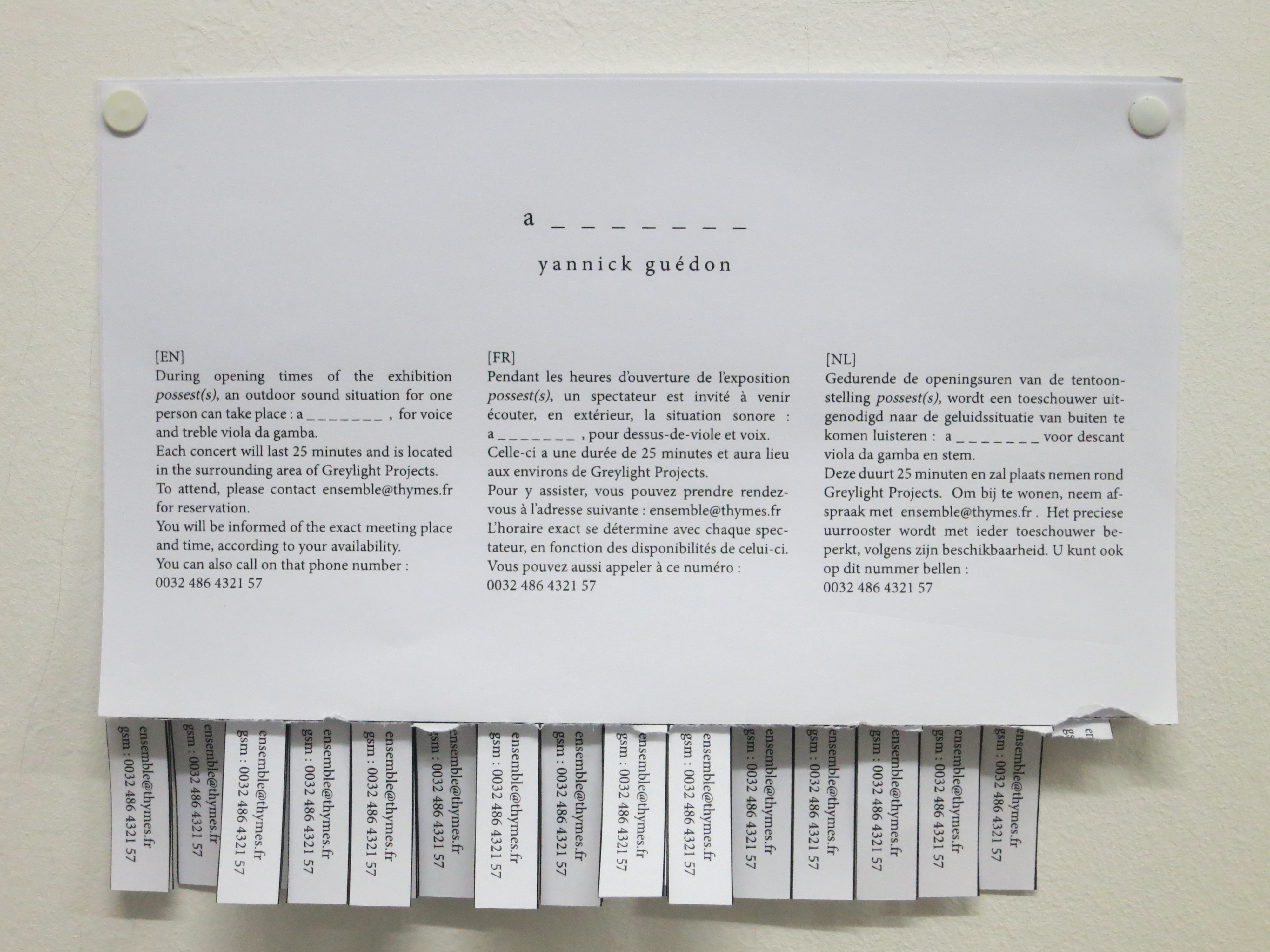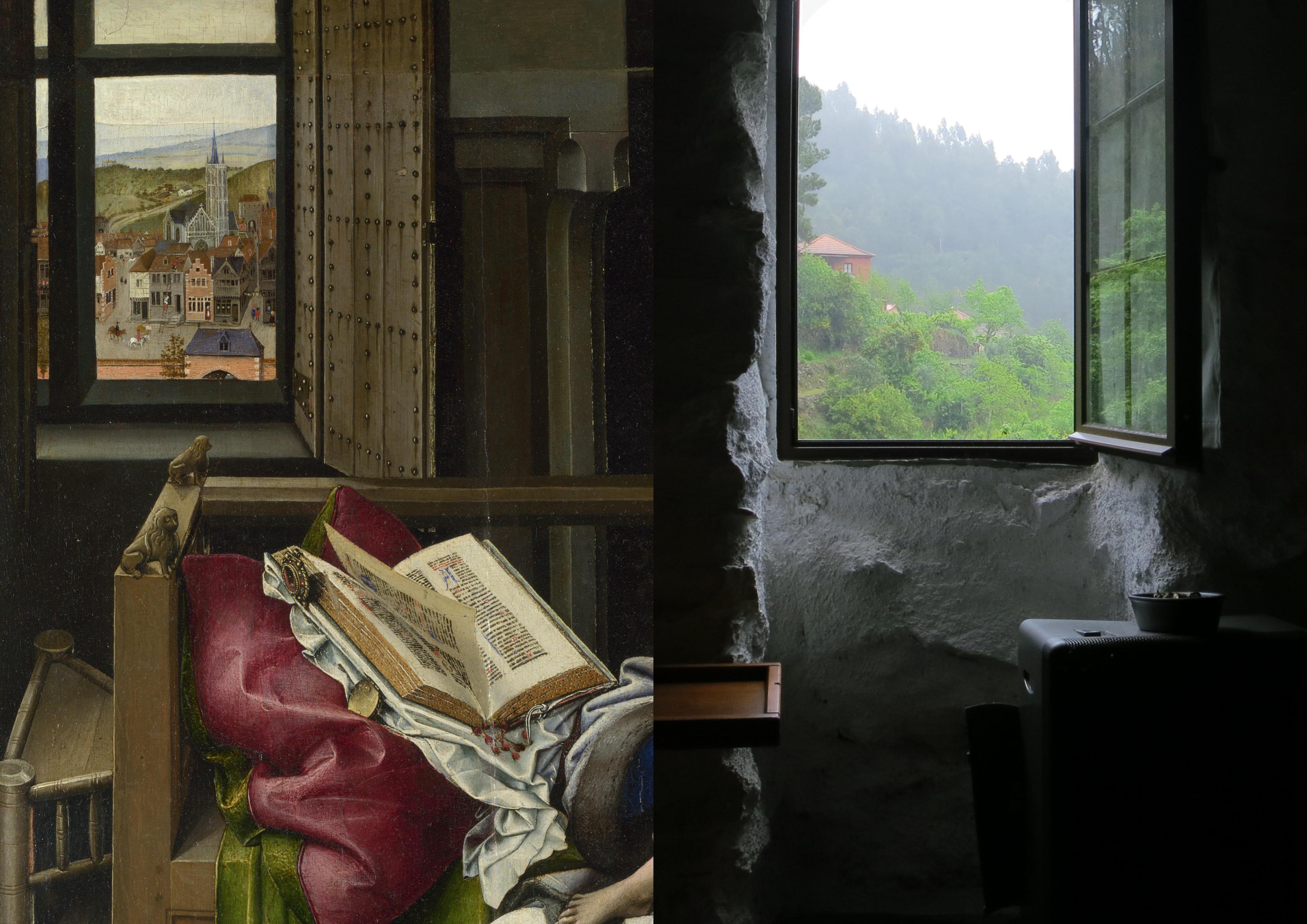
Melt the sound of the voice in the single note played on treble viola da gamba.
Melt this mixture into the sound environment chosen for its noisiness.
With the voice, follow the harmonic series and tune each vocal partial for the same number of bowings.
Every day, invite a spectator to come and listen to this piece at a time of their choice.
Saturday May 2nd, 2015 et je m'apprête à jouer la pièce I am about to play the sound piece 'a _ _ _ _ _ _ _ ' in the bedroom of the cottage where I am staying, in Açores, a remote hamlet of seven inhabitants. The cottage is situated at the end of a little country road, at the top of a rocky promontory on the inner edge of a meander in a small river. Thanks to its multiple openings, the bedroom on the second foor of the house offers different views on the valley : one door and one window to the east, two windows to the south, and three to the west. From these openings, one can see the river flowing from west to east towards the village of Sul, three kilometers downstream. The sound of the river is very present and it is emphasized as the river passes through several weirs along its course.
As the spectators enter the bedroom, I invite them to sit wherever they like on the available beds, chairs, cushions and mats. The door and the windows are closed. The windows are covered with white cotton curtains that let the daylight enter the bedroom but obscure the view of the landscape. For now, the sounds of the environment are muffed, barely perceptible. Before starting to play, I inform the audience that they can leave the space whenever they want. A way to let them choose an end to the piece I will perform for one hour and a half.
The concert can start.
> listen to the excerpt of the concert
I open the wardrobe on my right and take out my treble viola-da-gamba. Then I sit down before the only wall without openings, my back to the north. I first play one bowing on the lowest string of the viol – silence – then two bowings on the same tone – silence. I stand up and open the door on my left, to the east. The sound of Pierre Berthet's installation enters into the bedroom and prolongs the note just played on the viol. It's a drone generated by a wire whose vibration resonates in an abandoned shed in the garden.
I come back to my chair then resume the series I started before by playing three bowings – silence – then four – silence. I get up again to open the window on the right of the door, overlooking the hamlet. From this window, I often see a woman tending her sheep, or hear the dog barking whenever someone walks past its house. The sound of a second installation of Pierre Berthet is heard more distinctly : it consists of drops of water, defected from a pipe, that fall on resonating objects.
I return to my place and play five bowings – silence – then six – silence. I get up and open the window beside the first one. The sound of the river is now much more present.
I go on with this process until the end of the concert. Each time, I add one bowing to the previous series, and each two series, I open a window, progressively revealing the landscape, both visually and sonorously. When I open the first window on the west side, Helena Espvall starts her concert with her amplified cello on the other side of the river. Now, three pieces of art interact : Pierre's installations, Helena's concert and my own performance, all subject to the vagaries of the surrounding sounds. From the bedroom, the three are perceived as very singular proposals and since the viol is played softly, none overwhelm the others.
I always play the same note on the viol but this sound is enriched gradually by others. Those of my voice. I hide the fundamental note of my voice in the one of the viol, and develop the natural harmonics series with subtle vocal overtones. Each bowing is related to a specifc vocal harmonic of the series. The first harmonics emphasize those of the viol ; the following ones emerge little by little from the sound of the instrument and become more discernible. The score could be simply written like this :
1_2
open the door
1_2_3
1_2_3_4
open the first window
1_2_3_4_5
1_2_3_4_5_6
open the second window
1_2_3_4_5_6_7
etc.
Each number corresponds to a bowing and the related number of the harmonics series. Consequently, there is a perpetual return to the beginning of the series, a way to deepen our listening to what has been already played but not necessarily heard - because one does not necessarily perceive at first that the progressive coloration of the sound of the viol is produced by the harmonics of the voice.
When all the windows are open, I go on with the score and start to close them in the same clockwise direction. The closing generates a different configuration than the openings : the first window opened was on the east side, the last one to stay open is on the west side.
After having closed the last window, I end the concert by putting the viol back into the wardrobe.
Addendum
A few days before performing this piece, this is what I read :
Paris, Hazan, 1995

&
View of the hamlet of Açores from the cottage
exposition Possest(s) - Greylight Project, Bruxelles - 17th October to 15th November 2014
76, bd Waterloo – 1000 Bruxelles / q-o2, Bruxelles - 2nd to 14th July 2014
Festival Forma, le PAD, Angers - 12th December 2015
q-o2, Bruxelles - 6th July 2014
studio plasky, Schaerbeek - 28th February 2014
26 chaises, Paris - 10th April 2023
Soccos – Binaural, Açores, Sao Pedro do Sul, Portugal - 2nd May 2015
Festival Sans-Dessus-de-Sault, avec Loïc Guénin - 30th May 2015
Soccos – Binaural, Açores, Sao Pedro do Sul, Portugal - 12-24 April et 29th Avril - 2nd May 2015
résidence SPAM-Association Tsunami, Nîmes - 19th January to 6 February 2013